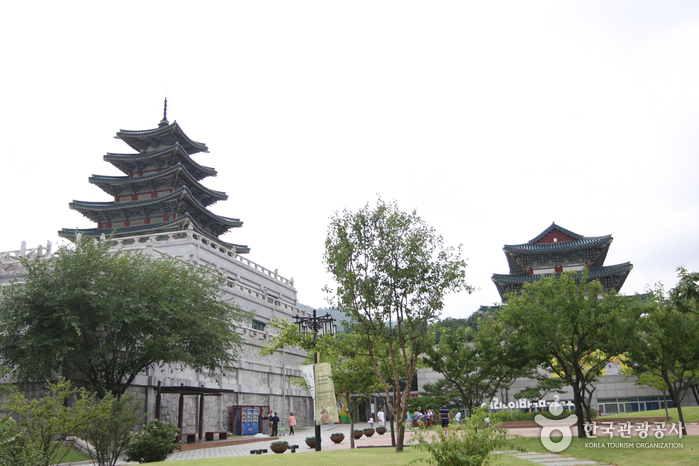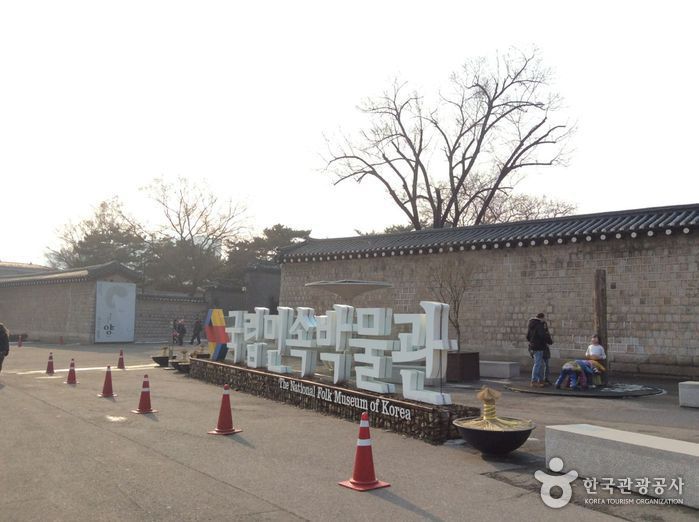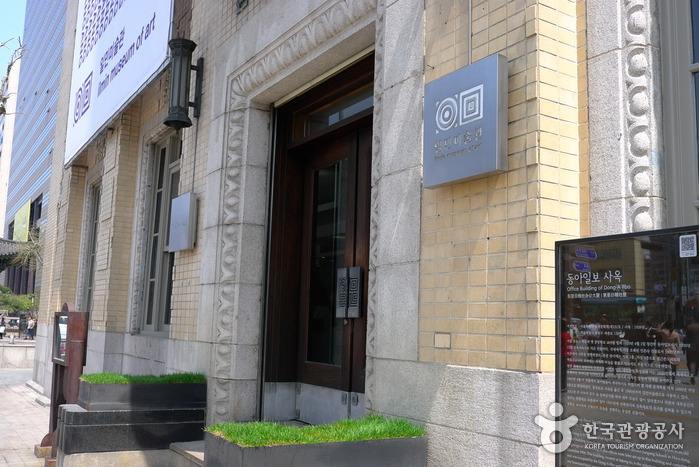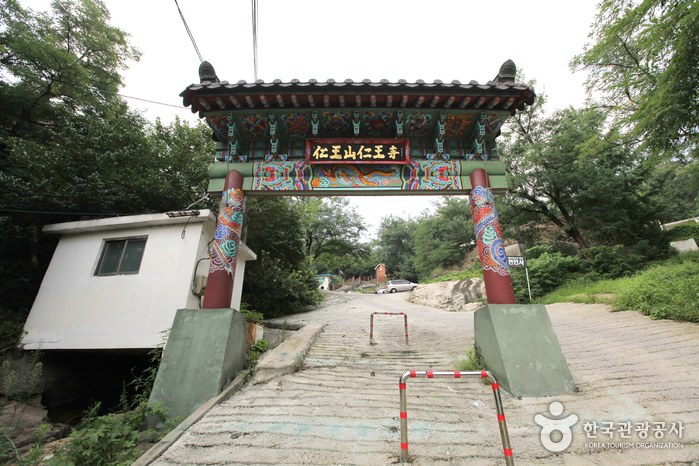Songhyeon Green Plaza (열린송현 녹지광장)
964.3M 2025-06-17
Songhyeon-dong, Jongno-gu, Seoul
Songhyeon Green Plaza, located between Gyeongbokgung Palace and Jongno, is a space for culture and rest. The site was formerly used as housing for Shiksan Bank during Japanese rule. After Korea’s liberation, it served as a residence for the US Embassy and military personnel. Later in 1997, it was returned to the Korean government but remained unused for years. In 2022, the ownership was transferred to the Korean House and Land Corporation and then to the Seoul Metropolitan Government, which redeveloped it into a green plaza and opened it to the public. Upon entering the plaza, visitors are greeted by a spacious lawn adorned with flowers during the blooming season. The plaza is connected to the nearby tourist attractions through shortcuts cutting through it, including Cheong Wa Dae (Blue House), Gwanghwamun Plaza, Insa-dong, and Bukchon Hanok Village.
Uniqlo - Gwanghwamun D Tower Branch [Tax Refund Shop] (유니클로 광화문D타워)
966.0M 2024-04-17
17, Jong-ro 3-gil, Jongno-gu, Seoul
-
The National Folk Museum's Korean Folk Performances for Visitors (국립민속박물관 우리민속한마당)
971.0M 2021-07-07
37, Samcheong-ro, Jongno-gu, Seoul
• 1330 Travel Hotline: +82-2-1330 (Korean, English, Japanese, Chinese) • For more info: +82-2-3704-3114
The National Folk Museum is the leading museum depicting Korean folk culture that attracts 3 million visitors every year. Every Saturday, the museum offers free performances where Korean music, traditional dance, martial arts, and mask plays are performed for Korean and international spectators to illustrate Korea’s major seasonal events, special exhibitions, and traditional intangible cultures.
National Folk Museum of Korea (국립민속박물관)
971.0M 2019-03-19
37, Samcheong-ro, Jongno-gu, Seoul
Located inside Gyeongbokgung Palace, the National Folk Museum of Korea presents historical artifacts that were used in the daily lives of Korean people in the past. Through the displays, visitors can learn about the domestic and agricultural lifestyles, as well as Korea’s cultural beliefs.
The National Folk Museum of Korea has three permanent exhibitions and two special exhibitions as well as a library, souvenir shop, and other subsidiary facilities.
National Folk Museum of Korea Children’s Museum (국립민속박물관 어린이박물관)
971.0M 2019-03-18
37, Samcheong-ro, Jongno-gu, Seoul
+82-2-3704-4540, 4524
The Children’s Museum is a hands-on experience museum run by the National Folk Museum of Korea. A variety of visual aids and assembly models allow children to touch and feel pieces and experience folk history in an interactive way. The theme of the exhibitions consists of folk clothing, food, shelter, social life, and entertainment. The museum has a number of interactive spaces including a table set for an ancestral ritual, magnet miniatures depicting a baby’s first birthday, and an area where young visitors can build a folk house. Young learners can also create an avatar wearing in Hanbok, make kimchi using visual aids, or play gonu (a traditional board game). The museum also collects, preserves, and maintains relics and historical items related to youth and youth culture.
The Great Full Moon Festival (정월대보름 한마당)
971.0M 2025-02-05
37 Samcheong-ro, Jongno-gu, Seoul
+82-2-3704-3106
The National Folk Museum is celebrating the first full moon of the Lunar new year, Jeongwol Daeboreum. A variety of experiences are prepared to eliminate bad luck and pray for prosperity and health. The event provides a chance for locals and tourists alike to learn more about the traditional culture of Korea.
Ilmin Art Museum (일민미술관)
972.7M 2022-09-27
152, Sejong-daero, Jongno-gu, Seoul
The Ilmin Art Museum located in former Dong-A Newspaper Building, was formed in honor of their honorable and late CEO Kim Sang-man. The museum was established in December of 1996, and with a full renovation in 2001, large exhibition hall and Ilmin collection was placed in. Through the renovation, the combination of glass and steel made Artrium aimed to become one of the best comtemporary museum, connecting the museum to the streets of Gwanghwamun.
This museum boasts a large Ilmin collection. There are 430 pieces of Ilmin collection from Goryeo dynasty (918-1392) to present, 1,200 pieces in the Donga Newspaper's collection of art, and 100 pieces of art owned by Hyundai Corporation. The Ilmin Collection mostly consists of pieces that Kim Sang-man collected from ceramics to aesthetic paintings. The Dongah Newspaper's collection has time-relevant pieces that are important in history.
Inwangsa Temple (인왕사 (서울))
980.6M 2020-04-02
16-1, Tongil-ro 18ga-gil, Jongno-gu, Seoul
+82-2-737-4434
Inwangsa Temple refers to the entire cluster of small Buddhist temples located on Inwangsan Mountain (alt. 338m) in the heart of Seoul. The eastern foot of the mountain has many scenic spots with its distinctively cozy and tasteful atmosphere, and the northern area called Mugye-dong also offers beautiful scenery. Inwangsa Temple was established in the early Joseon period (1392-1910) to guard the national palace Gyeongbokbung. The temple is comprised of 11 shrines from five different Buddhist orders. The unique design of each shrine adds pleasure to hikers on their way up to Seonbawi, an unusual rock formation that is a site of many folk beliefs and shamanist rites.
Olive Young - Jeongdong Branch [Tax Refund Shop] (올리브영 정동)
995.4M 2024-04-22
26, Saemunan-ro, Jung-gu, Seoul
-
Hwangsaengga Kalguksu (황생가칼국수)
996.0M 2024-03-18
78 Bukchon-ro 5-gil, Jongno-gu, Seoul
+82-2-739-6334
Hwangsaengga Kalguksu is a specialty restaurant located near Gyeongbokgung Palace, known for its kalguksu (noodle soup). Kalguksu is a type of noodle soup made by thinly slicing dough into noodles with a knife and boiling them in a broth made from beef bones, clams, or seafood. Their menu includes options like wang mandu (jumbo mandu), hanu suyuk (boiled Korean beef slices), kongguksu (noodles in cold soybean soup), beoseot jeongol (mushroom hot pot), and mandutguk (mandu soup). It was selected as a Michelin Guide Seoul 2023 restaurant.
![Uniqlo - Gwanghwamun D Tower Branch [Tax Refund Shop] (유니클로 광화문D타워)](http://tong.visitkorea.or.kr/cms/resource/15/2878215_image2_1.jpg)






![Olive Young - Jeongdong Branch [Tax Refund Shop] (올리브영 정동)](http://tong.visitkorea.or.kr/cms/resource/11/2888011_image2_1.jpg)
 English
English
 한국어
한국어 日本語
日本語 中文(简体)
中文(简体) Deutsch
Deutsch Français
Français Español
Español Русский
Русский